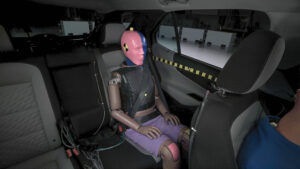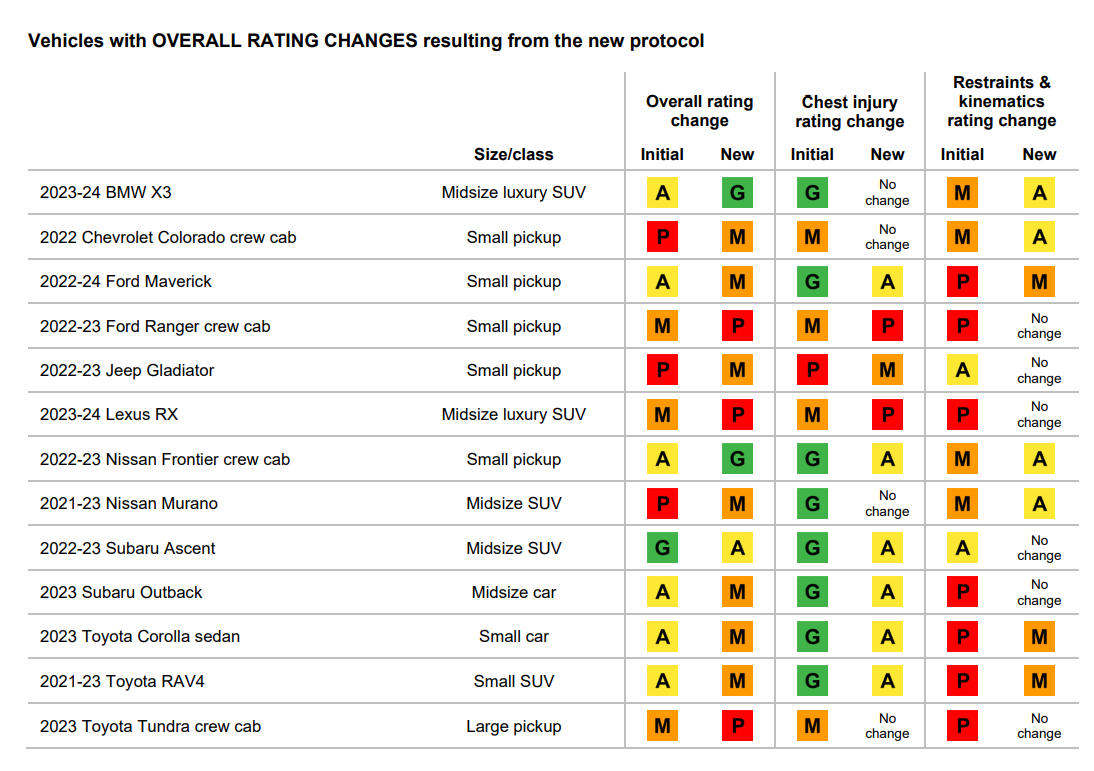
IIHS says new metric more accurately determines rear shoulder belt effectiveness
By onAnnouncements
The Insurance Institute for Highway Safety (IIHS) has rolled out new scoring criteria for its updated moderate overlap front crash test that it says better accounts for variations in the position of rear shoulder belts.
A new chest index metric factors both the position of the shoulder belt on the rear dummy’s chest and chest compression. The belt position is also evaluated on how well it restrains motion in crash test dummy tests, the range of which is considered acceptable has been expanded slightly.
Previously published ratings in the updated moderate overlap test that was launched in 2022 have been adjusted, including the ratings of five vehicles seeing improvement and eight downgraded. An analysis of 14 years’ worth of crash data involving IIHS-rated vehicles shows that the driver of a model rated good in the original moderate overlap test is 46% less likely to die in a head-on crash with a similar vehicle compared to the driver of a model rated poor, according to IIHS. A separate analysis shows that the driver of a vehicle rated good in the driver-side small overlap front test is 12% less likely to be killed in any type of frontal crash than the driver of a vehicle with a poor rating.
An analysis of 14 years’ worth of crash data involving IIHS-rated vehicles shows that the driver of a model rated good in the original moderate overlap test is 46% less likely to die in a head-on crash with a similar vehicle compared to the driver of a model rated poor, according to IIHS. A separate analysis shows that the driver of a vehicle rated good in the driver-side small overlap front test is 12% less likely to be killed in any type of frontal crash than the driver of a vehicle with a poor rating.
“Most of these changes are part of a planned transition that we informed automakers we’d be making before we launched the updated test a year ago,” said Jessica Jermakian, IIHS vice president of vehicle research, in a news release. “The new scoring eliminates an artificial benefit our initial ratings awarded for a high shoulder-belt position. Pressing ahead with a simpler program while we validated the new metric allowed us to start incentivizing vehicle improvements a year earlier.”
IIHS launched the updated test after research showed that in newer vehicles the risk of a fatal injury is higher for belted occupants in the second row than for those in front, however, not because the second row has become less safe. Instead, the front seat has become safer because of improved air bags and advanced seat belts that are rarely available in the back, IIHS determined.
The back seat remains the safest place for children who can be injured by an inflating front air bag, and the rating doesn’t apply to children properly secured in child safety seats, according to IIHS.
In the updated test, a dummy the size of a small woman or 12-year-old child is positioned in the second row behind the driver dummy.
For a vehicle to earn a good rating, there can’t be an excessive risk of injury to the chest, among other body regions, as recorded by the second-row dummy.
During the first year of testing, IIHS engineers estimated the risk of chest injuries with a device that records the seat belt tension and the dummy’s chest deflection sensor, which measures how much the rib cage is compressed by the force of the crash. This was carried out using only a pressure mat to avoid delaying the program launch. The mat tracked the position of the shoulder belt and penalized vehicles when a maximum height was exceeded.
Vehicles with shoulder belts higher than the cutoff could receive no better than a marginal rating for chest injury risk, regardless of how little chest deflection the dummy’s internal sensor recorded.
The new chest index metric considers both chest deflection and belt position using a formula IIHS has been validating for the past year, adjusting the deflection metric based on the distance of the shoulder belt from the internal sensor.
The pressure mat is still used to determine the maximum shoulder belt position during the crash. However, engineers now evaluate maximum belt position separately in their assessment of how well the restraints control the motion of the dummy, which reduces the influence of shoulder belt height on the overall rating.
The cutoff for a belt that is too high has been raised by 10 millimeters in recognition of the need for shoulder belts to accommodate occupants of various sizes, IIHS said. These changes were not part of the original phase-in plan.
The belt tension metric, which makes it very difficult for a vehicle without technology like pre-tensioners and belt force limiters to earn a good rating, remains the same.
Images
Featured image and ratings chart provided by IIHS
More information
IIHS safety tests 4 pickups, all fail to protect backseat passengers
